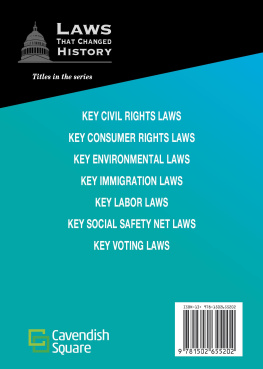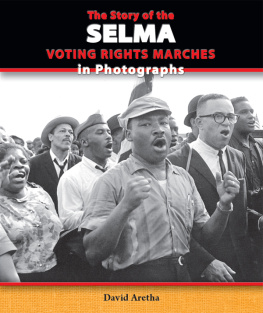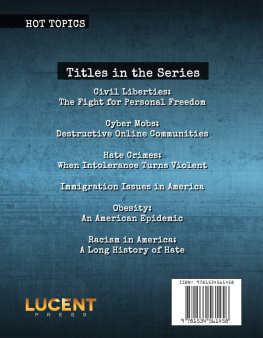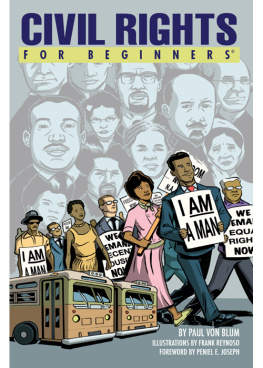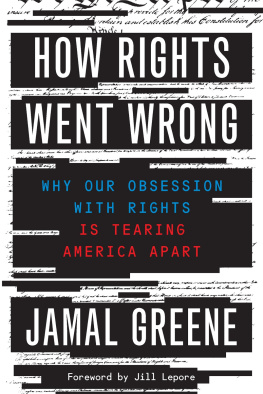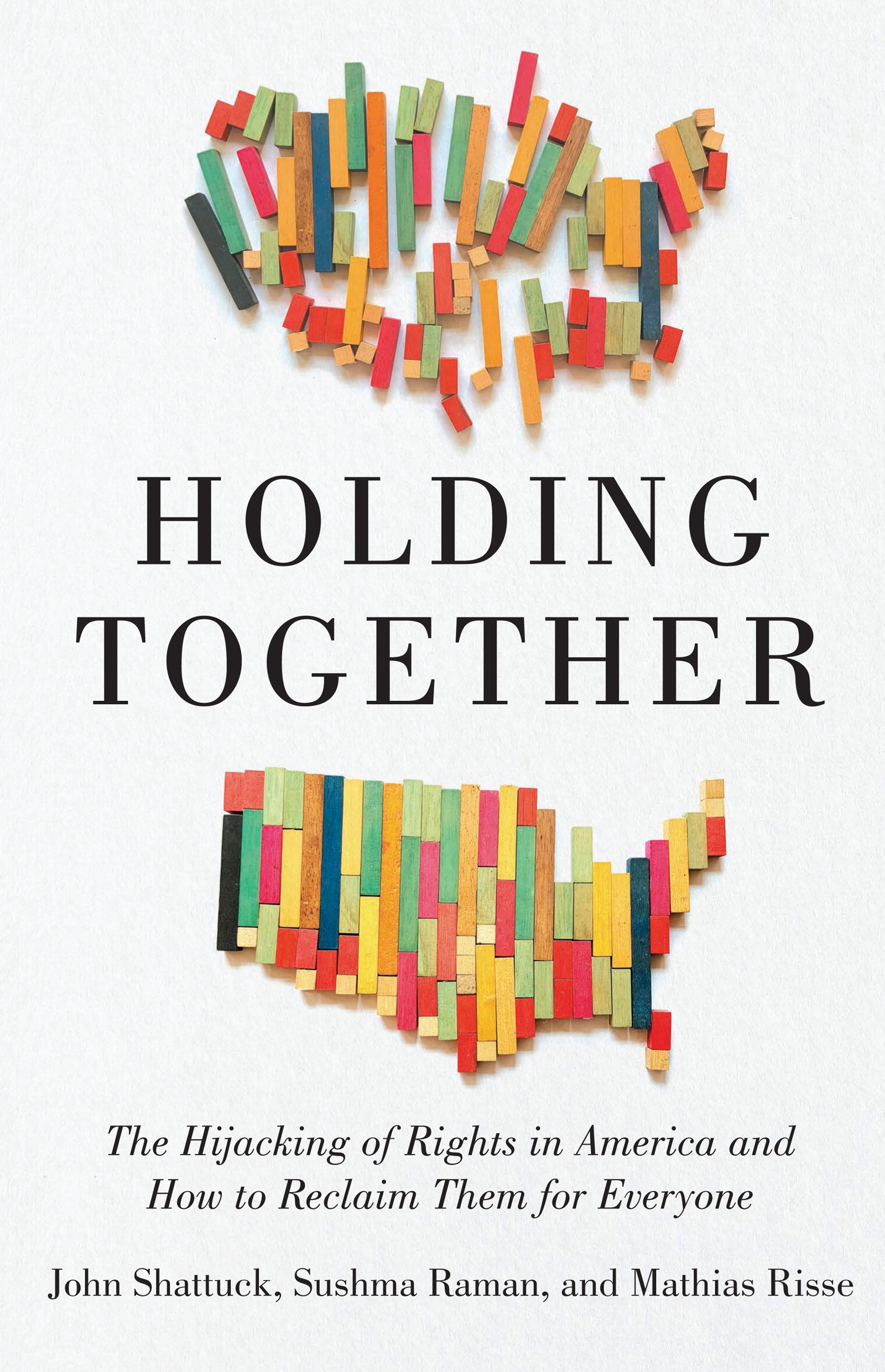Contents
List of Figures
Guide
Pagebreaks of the Print Version
HOLDING TOGETHER
THE HIJACKING OF RIGHTS IN AMERICA AND HOW TO RECLAIM THEM FOR EVERYONE
JOHN SHATTUCK, SUSHMA RAMAN, AND MATHIAS RISSE

Dedicated to the legacies of John Lewis and Ruth Bader Ginsburg
CONTENTS
FOREWORD
MARTHA MINOW
Rights are both ideals and measures of the shortfall of human societies. The distance between rights declared and realized in the United States has inspired struggles for change through politics, education, and law even before the nation started. Setbacks in the realization of rights motivate the thoroughgoing and vigorous chapters of this timely book. Integrating history, politics, public opinion data, and law, Holding Together shines a blazing light on both the promise of rights and the paths needed to realize that promise.
Bridging the distance between promise and reality of rights requires facts, norms, agitation, and above all, the motivation to pursue the challenge. Justice Thurgood Marshall once explained, A child born to a Black mother in a state like Mississippi has exactly the same rights as a White baby born to the wealthiest person in the United States. Its not true, but I challenge anyone to say it is not a goal worth working for. Providing an unflinching view of the distance between stated ideals and actual practices, this book makes the case for connecting the ideal and the real in treatments of voting rights, money in politics, civic education, racial justice, womens rights, and rights for people with diverse sexual and gender identities. Political polarization and technological changes challenge the realization of rights and compound the tensions perhaps unavoidably present if rights are to reach everyone. There are tensions between rights and also between rights and other social goods. Consider free speech versus freedom from violent hatreds, religious liberty versus womens rights and LGBTQ rights, gun rights versus public safety, and personal privacy versus security afforded by digital and surveilling technologies. Similarly, the practices of police, courts, and prisons and the treatment of immigrants and asylum-seekers reflect the tensions between ideals of individual dignity and equality and claims of community safety and security. Lessons from historical struggles and attention to current contexts are essential starting points for strategies to bridge the distance between the ideals and the reality. The discipline to craft concrete policy recommendations is the challenge powerfully accepted by this book as it tackles the often-cavernous gap between what is and what should be.
The United States did not invent rights. But the nations identity is bound up with the legal, political, and moral commitment to freedom and equality for each individual. Indeed, it is rights that hold Americans who lack common ethnicity, religion, and ancestry together. Yet the realities are riven by failures, struggles, conflicts, and contradiction. The stirring words of the Declaration of Independence hold as self-evident that all men are created equal; that they are endowed by their Creator with certain unalienable rights; that among these are life, liberty, and the pursuit of happiness. Its author Thomas Jefferson enslaved more than six hundred human beings over the course of his lifetime. Along with other founders of the nation, Jefferson endorsed a constitution significantly departing from the Declarations announced vision.
When celebratory narratives of social movements and courageous leaders depict ever-expanding circles of inclusion for American rights, they must be met with sober study of set-back and backlash. This contrast is echoed in debates over the nations narrative and even over the facts. The New York Times marked the 400th anniversary of slavery in America with the 1619 historical report of Americas original sin and its living legacies. This initiative in turn triggered varied controversies and also prompted President Donald Trump to launch the 1776 Commission and its contrary, triumphant report. Beyond the experts views about factual details and theories of causation, the dispute reflects sharp disagreements over Americas future prospects.
The stories of the past are mobilized as part of ongoing conflicts over both the vision and reality of rights in America. Antislavery social reformer Frederick Douglass taught, Without a struggle, there will be no progress. So it is with any effort to redeem the promise of rights. Even what counts as progress elicits debate and struggle. Admirably clear about what counts as progress, this book embraces a distinctive and ambitious view of rights affirming the identities, equal chances, and security for all persons.
Most striking in this clear-eyed and engaged work of scholarship is the repeated demonstration that current overt policies in the United States block and impair rights in ways directly opposed by significant majorities of Americans. As the book demonstrates, opinion polls show large bipartisan majorities of Americans want to protect voting rights with legislated improvements to facilitate early voting and reduce voting restrictions. Supermajorities of both parties want independent commissions to determine the map of legislative districts rather than partisan gerrymandering. Americans overwhelmingly want sharp reductions of unregulated money in election campaigns, with federal enforcement of rules and disclosure of all donors to campaigns. Nonetheless, the Supreme Court has issued decisions making any such reforms difficult to adopt and enforce.
Similarly, a substantial majority of Americans believe abortion should be legal in at least most cases if not always. They are more concerned about policies making abortion too difficult to obtain than policies making it too easily available, despite Supreme Court decisions proceeding in the opposite direction. A supermajority of people from both major political parties who responded to a survey endorse limits on gun sales through gun shows without private background check. Accountability by police for violent or unlawful behavior, and independent review of complaints of police misconduct, garner overwhelming public support. Yet such policies are ensnared in political and union opposition. Laws against hate crimes, environmental protection for members of marginalized communities, protections against workplace barriers for persons with disabilities, access to quality education for all children, health care insurance coverage for everyone, and economic investment in African American, Native American, and Latinx American communities living with the results of discriminatory public policiesall of these elicit vibrant and powerful endorsement by substantial majorities. Political and court-made barriers stand in the way. The demand to guard personal privacy and ensure security of personal data echoes in responses of Republican and Democratic majorities who share desires to halt the spreading of disinformation by social media platform companies and reverse the jeopardy to democracy.
Nearly as many people of both parties also assert that Americans have more in common than many think. Although the protection of individual rights cannot be left to majorities, the endorsement of deep majorities for fundamental rights should propel action. And the gaps between Americans reported views and the laws, policies, and circulating narratives expose unacceptable defects in institutional practices and maybe even in their design in a nation ostensibly organized as a representative democracy. This means the legislatures are not in fact representative of the people. Instead, they show systematic deformities due to the self-interest of incumbents, the manipulation by dominant political parties, the influence of tiny numbers of large donors, and the structures established long ago to protect slaveholders. They also demonstrate the oddities and manipulations in federal judicial selection processes, and the failures of government agencies entrusted with public duties (such as the Federal Election Commission, effectively inoperable for several years).


